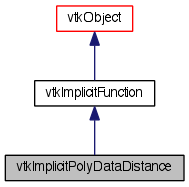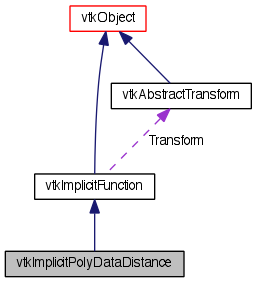#include <vtkImplicitPolyDataDistance.h>


Detailed Description
Implicit function that computes the distance from a point x to the nearest point p on an input vtkPolyData. The sign of the function is set to the sign of the dot product between the angle-weighted pseudonormal at the nearest surface point and the vector x - p. Points interior to the geometry have a negative distance, points on the exterior have a positive distance, and points on the input vtkPolyData have a distance of zero. The gradient of the function is the angle-weighted pseudonormal at the nearest point.
Baerentzen, J. A. and Aanaes, H. (2005). Signed distance computation using the angle weighted pseudonormal. IEEE Transactions on Visualization and Computer Graphics, 11:243-253.
This code was contributed in the VTK Journal paper: "Boolean Operations on Surfaces in VTK Without External Libraries" by Cory Quammen, Chris Weigle C., Russ Taylor http://hdl.handle.net/10380/3262 http://www.midasjournal.org/browse/publication/797
Definition at line 50 of file vtkImplicitPolyDataDistance.h.
Member Typedef Documentation
Reimplemented from vtkImplicitFunction.
Definition at line 54 of file vtkImplicitPolyDataDistance.h.
Constructor & Destructor Documentation
| vtkImplicitPolyDataDistance::vtkImplicitPolyDataDistance | ( | ) | [protected] |
| vtkImplicitPolyDataDistance::~vtkImplicitPolyDataDistance | ( | ) | [protected] |
Member Function Documentation
| static vtkImplicitPolyDataDistance* vtkImplicitPolyDataDistance::New | ( | ) | [static] |
Create an object with Debug turned off, modified time initialized to zero, and reference counting on.
Reimplemented from vtkObject.
| static int vtkImplicitPolyDataDistance::IsTypeOf | ( | const char * | name | ) | [static] |
Return 1 if this class type is the same type of (or a subclass of) the named class. Returns 0 otherwise. This method works in combination with vtkTypeMacro found in vtkSetGet.h.
Reimplemented from vtkImplicitFunction.
| virtual int vtkImplicitPolyDataDistance::IsA | ( | const char * | name | ) | [virtual] |
Return 1 if this class is the same type of (or a subclass of) the named class. Returns 0 otherwise. This method works in combination with vtkTypeMacro found in vtkSetGet.h.
Reimplemented from vtkImplicitFunction.
| static vtkImplicitPolyDataDistance* vtkImplicitPolyDataDistance::SafeDownCast | ( | vtkObjectBase * | o | ) | [static] |
Reimplemented from vtkImplicitFunction.
| virtual vtkObjectBase* vtkImplicitPolyDataDistance::NewInstanceInternal | ( | ) | const [protected, virtual] |
Reimplemented from vtkImplicitFunction.
Reimplemented from vtkImplicitFunction.
| void vtkImplicitPolyDataDistance::PrintSelf | ( | ostream & | os, |
| vtkIndent | indent | ||
| ) | [virtual] |
Methods invoked by print to print information about the object including superclasses. Typically not called by the user (use Print() instead) but used in the hierarchical print process to combine the output of several classes.
Reimplemented from vtkImplicitFunction.
| unsigned long vtkImplicitPolyDataDistance::GetMTime | ( | ) | [virtual] |
Return the MTime also considering the Input dependency.
Reimplemented from vtkImplicitFunction.
| double vtkImplicitPolyDataDistance::EvaluateFunction | ( | double | x[3] | ) | [virtual] |
Evaluate plane equation of nearest triangle to point x[3].
Implements vtkImplicitFunction.
| void vtkImplicitPolyDataDistance::EvaluateGradient | ( | double | x[3], |
| double | g[3] | ||
| ) | [virtual] |
Evaluate function gradient of nearest triangle to point x[3].
Implements vtkImplicitFunction.
| void vtkImplicitPolyDataDistance::SetInput | ( | vtkPolyData * | input | ) |
Set the input vtkPolyData used for the implicit function evaluation. Passes input through an internal instance of vtkTriangleFilter to remove vertices and lines, leaving only triangular polygons for evaluation as implicit planes.
| virtual void vtkImplicitPolyDataDistance::SetNoValue | ( | double | ) | [virtual] |
Set/get the function value to use if no input vtkPolyData specified.
| virtual double vtkImplicitPolyDataDistance::GetNoValue | ( | ) | [virtual] |
Set/get the function value to use if no input vtkPolyData specified.
| virtual void vtkImplicitPolyDataDistance::SetNoGradient | ( | double | , |
| double | , | ||
| double | |||
| ) | [virtual] |
Set/get the function gradient to use if no input vtkPolyData specified.
| virtual void vtkImplicitPolyDataDistance::SetNoGradient | ( | double | [3] | ) | [virtual] |
Set/get the function gradient to use if no input vtkPolyData specified.
| virtual double* vtkImplicitPolyDataDistance::GetNoGradient | ( | ) | [virtual] |
Set/get the function gradient to use if no input vtkPolyData specified.
| virtual void vtkImplicitPolyDataDistance::GetNoGradient | ( | double & | , |
| double & | , | ||
| double & | |||
| ) | [virtual] |
Set/get the function gradient to use if no input vtkPolyData specified.
| virtual void vtkImplicitPolyDataDistance::GetNoGradient | ( | double | [3] | ) | [virtual] |
Set/get the function gradient to use if no input vtkPolyData specified.
| virtual double vtkImplicitPolyDataDistance::GetTolerance | ( | ) | [virtual] |
Set/get the tolerance usued for the locator.
| virtual void vtkImplicitPolyDataDistance::SetTolerance | ( | double | ) | [virtual] |
Set/get the tolerance usued for the locator.
| double vtkImplicitPolyDataDistance::SharedEvaluate | ( | double | x[3], |
| double | n[3] | ||
| ) | [protected] |
The documentation for this class was generated from the following file:
- dox/Filters/Core/vtkImplicitPolyDataDistance.h
 1.8.0
1.8.0